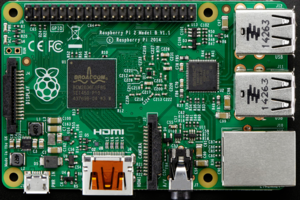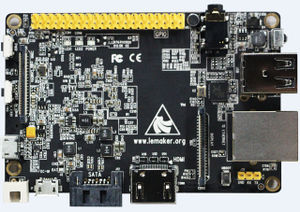Educational single board computer: Difference between revisions
m (→Banana) |
m (→Raspberry PI) |
||
| (3 intermediate revisions by the same user not shown) | |||
| Line 50: | Line 50: | ||
=== Banana Pi Pro === | === Banana Pi Pro === | ||
Banana PI, like Cubie Board is another SBC made in China. According to Wikipedia (March 2015), {{quotation|The Banana Pro is a credit card-sized and low-power single-board computer developed in China by the LeMaker Team, with the intention of promoting the STEAM (science, technology, engineering, art and mathematics) education in schools.}} | Banana PI, like Cubie Board is another SBC made in China. It was designed by a university team with connections to Maker movement. According to Wikipedia (March 2015), {{quotation|The Banana Pro is a credit card-sized and low-power single-board computer developed in China by the LeMaker Team, with the intention of promoting the STEAM (science, technology, engineering, art and mathematics) education in schools.}} | ||
: [http://www.lemaker.org/ LeMaker] (see also [http://www.bananapi.org/ BananaPi Official Website]) | : [http://www.lemaker.org/ LeMaker] (see also [http://www.bananapi.org/ BananaPi Official Website]) | ||
| Line 83: | Line 83: | ||
** [http://elinux.org/RPi_Education RPi Education] | ** [http://elinux.org/RPi_Education RPi Education] | ||
** [http://elinux.org/RPi_Tutorials RPi Tutorials] Target "embedded computing" problems. | ** [http://elinux.org/RPi_Tutorials RPi Tutorials] Target "embedded computing" problems. | ||
* [https://www.rs-online.com/designspark/raspberry-pi Raspberry articles at design spark] | |||
=== Banana === | === Banana === | ||
| Line 89: | Line 91: | ||
* [http://www.lemaker.org/ Lemaker.org] (Banana PI Pro) | * [http://www.lemaker.org/ Lemaker.org] (Banana PI Pro) | ||
* [http://wiki.lemaker.org/Main_Page Wiki] (LeMaker) | * [http://wiki.lemaker.org/Main_Page Wiki] (LeMaker) | ||
* [http://forum-bananapi.de/ German forum] | |||
[[Category: Hardware]] | |||
[[Category: Fab lab]] | |||
== Comparisons == | == Comparisons == | ||
Latest revision as of 18:20, 10 April 2017
Introduction
An single board computer (SBC) is “is a complete computer built on a single circuit board, with microprocessor(s), memory, input/output (I/O) and other features required of a functional computer. Single-board computers were made as demonstration or development systems, for educational systems, or for use as embedded computer controllers. Many types of home computer or portable computer integrated all their functions onto a single printed circuit board.” (Wikipedia, March 19, 2015).
Educational single board computers are not different from others, but target education in one way or another. Various small SBCs, such as the Raspberry PI specifically target education: “The Raspberry Pi is a series of credit card-sized single-board computers developed in the UK by the Raspberry Pi Foundation with the intention of promoting the teaching of basic bbcomputer science in schools.”
Today, most SBCs are very small, i.e. about the size of a credit card. Connectors allowto connect the machine to a screen and a keyboard. SBC's cost as little as US$25 (plus costs for an adaptor, Micro SD card and cables). In the past, the BBC Micro (UK), Spectrum (UK), the Commodore (Amiga) and the Amstrad were popular SBCs. However, they were much bigger (built underneath a keyboard) and more expensive.
Hardware and OS
The (probably) first computer of this class was the Raspberry Pi and it was launched in February 2012. By 2015 it sold about 5 million units. As of 2015, small educational SBCs can replace personal computers and most can run a variety of operating systems, including Linux, Android and Windows. Many are open source hardware.
It is difficult to tell what category of computers could actually fit into "educational single board computer". Price and size are certainly factors. I.e. some more expensive devices like cellphones or USB stick size ones do not fit as of 2015.
See also Wikipedia's various articles, e.g.
- Comparison of single board computers
- Small form factor (see ultra-compact form factor)
- PC-on-a-stick
Below is a selection of SBCs used in education (but there are more !)
Raspberry PI 2
- RaspberryPi.org, Official web site.
- Processor: Cortex-A7 ARM @ 900MHz
- OS: Linux (various, e.g. Ubuntu Snappy Core), Android, Windows 10
- Cost: $35 (bulk shipping) / $45 single units, but a complete kit (cables, housing, SD card, Adaptor, keyboard, etc.) costs around 100$/Euros. The http://swag.raspberrypi.org/collections/pi-kits/products/raspberry-pi-2-starter-kit[ official Raspberry PI 2 Starter Kit] cost £75. (March 2015).
- Optional Modules: PI Camera
- Ethernet, 4 USB, 1 MicroSD,
“The Raspberry Pi is a low cost, credit-card sized computer that plugs into a computer monitor or TV, and uses a standard keyboard and mouse. It is a capable little device that enables people of all ages to explore computing, and to learn how to program in languages like Scratch and Python. It’s capable of doing everything you’d expect a desktop computer to do, from browsing the internet and playing high-definition video, to making spreadsheets, word-processing, and playing games.” (What is a Raspberry Pi?, March 2015)
Cubie Board 4
Cubie Boards are a bit more recent than Raspberries and were designed and made in China since sept. 2012.
- official site
- 2GB RAM
- OS: Android, Ubuntu Linaro desktop, and Debian Server
- Ethernet, 2 USB, 1 Micro SD slot, 1 SATA slot
- CPU: 4x Cortex-A15 @ 2 GHz ?
- 130 Euros (Board, Power, USB cable, WIFI Antenna)
“Cubieboard4 also named CC-A80, is an open source mini PC or single board computer which has ultra-powerful performance and mainly aims to office, games and entertainment… The main chipset Allwinner A80 is a 28nm Octa-Core A15/A7 big.LITTLE architecture application processor with a CPU dominant frequency of 2GHz. It also has the amazing GPU 64-core GPU graphics core PowerVR G6230 which supports openGL ES, openGL, even openCL. CC-A80 has the standard interfaces like desktop computer, such as HDMI&VGA, 100M/1000M RJ45, 4 USB2.0 host ports,1 USB3.0 OTG port, Audio output, Microphone input, dual-band wifi and bluetooth 4.0, micro SD card. It has 2GB DDR3 on-board memory and support Li-Po battery UPS power input, so that we can say it’s a good mobile development platform.” (CubieBoard4/CC-A80 Released, March 10, 2015).
Banana Pi Pro
Banana PI, like Cubie Board is another SBC made in China. It was designed by a university team with connections to Maker movement. According to Wikipedia (March 2015), “The Banana Pro is a credit card-sized and low-power single-board computer developed in China by the LeMaker Team, with the intention of promoting the STEAM (science, technology, engineering, art and mathematics) education in schools.”
- LeMaker (see also BananaPi Official Website)
- 1 GHz ARM Cortex-A7 Dual-core
- 1GB DDR3 DRAM
- OS: Android, Debian, Ubuntu, Raspian
- 2 USB 2.0 host, 1 USB 2.0 OTG
- 1 MicroSD, 1 STAF 2.0, Ethernet
- 90x60 mm
- 40 Euros (or less) for the board.
- 92 x 60mm
- Supported apps: Scratch
BeagleBone Black X15
- Beagleboard.org
- AM335x 1GHz ARM® Cortex-A8
- 512MB DDR3 RAM
- OS: Debian, Android, Ubuntu, ....
“BeagleBone Black is a low-cost, community-supported development platform for developers and hobbyists. Boot Linux in under 10 seconds and get started on development in less than 5 minutes with just a single USB cable.” (BeagleBone Black, March 2015).
A more powerful BeagleBone X15 (dual core, with more RAM) is in preparation according to elinux.org as of March 2015.
Links
Raspberry PI
- Raspberry Pi Foundation
- MagPi, the the official Raspberry Pi magazine.
- Raspberry Pi Wiki, supported by the RPF (elinux.org)
- RPi Education
- RPi Tutorials Target "embedded computing" problems.
Banana
- Bananapi.org (Banana PI)
- Lemaker.org (Banana PI Pro)
- Wiki (LeMaker)
- German forum
Comparisons
- Arduino vs. Raspberry Pi vs. CubieBoard vs. Gooseberry vs. APC Rock vs. OLinuXino vs. Hackberry A10, Feb 2013 (it does not concern more recent models).
- Best alternatives to the Raspberry Pi 26 July 2014


